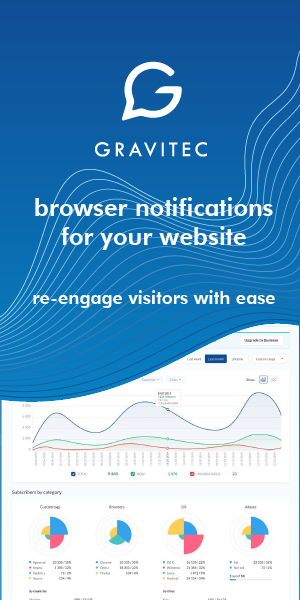Pop-ups are an effective way to convert your website’s visitors into customers. Sumo’s research says that the average conversion rate for a website pop-up is 3.09%. That’s higher than just directing users to a landing page with a subscription form: the average conversion rate for any website landing page is 2.35%.
The right WordPress popup plugin is a make-or-break factor to create a well-designed pop-up for your website. We’ll help you choose the best WordPress pop-up plugins and walk you through the installation process.
What is a Pop-up Form
A pop-up form is usually a small window that pops up or over your website when a user is browsing. You can use pop-ups to offer discounts, promote sales or specific content, grow your subscriber list or reduce bounce rates. And according to Sumo’s study, they’re quite successful at that: the top performing 10% of pop-ups convert at 9.3%.
Pop-ups show up either triggered by user’s inactivity or action, like exit-intent pop-ups, time spent on the page, specific pages, or even the users’ location.
There are many kinds of pop-ups you can use to get leads, for example:
- on-click pop-ups appear when a user clicks the anchored text
- floating bar pop-ups that look just like floating banners, you trigger to show up at a specific time
- slide-in pop-ups are smaller boxes of promotional information
- gamified pop-ups like a spin wheel pop-up, create a game your users can play
- yes/no pop-ups typically have multiple steps asking users questions
- full-screen pop-ups that cover the entire browser screen

You can use pop-ups together with other marketing tactics like squeeze pages or push notifications. Pushes will help you turn visitors into leads. As website visitors first agree to receive them, they prove effective, so you’re dealing with a warm audience. The pushes will also be delivered whether a person is currently browsing or not. You can send and automate welcome messages, updates, special offers, and new content. You can set up triggers for your notifications and create drip campaigns to build connections with your users. It’s quite an effective technique — users you set up contact with make 47% greater purchases than non-nurtured leads.
How to Choose the Best Pop-up Plugin
Here are the factors to take into consideration when choosing a pop-up plugin. You will want to choose a plugin that:
- gives you control over user experience;
Imagine you landed on a website for the first time. After just a few seconds, a lightbox pop-up shows up that dims everything but the pop-up that asks you to subscribe. However, you still have no idea what the website is about, so you either close the pop-up without reading it or leave the website. So, choose a plugin that gives you full control over when the pop-up shows up for your website’s visitors and offers a choice of triggers like scroll depth, clicks, time on page, and exit intent. - has various targeting options, like page-level targeting, geolocation, device, and traffic source;
- doesn’t affect your site’s performance; If your pop-up plugin slows down your website, it will negatively affect your SEO ranking and annoy your website’s visitors. So, you need to choose a plugin that helps convert visitors into subscribers without the site’s speed being affected.
- provides a variety of templates to speed up the creation process.
- integrates with your favorite email marketing service; It will make it easier for you to set up a newsletter for your subscribers.
- offers multiple customization options. You’ll need to create a pop-up that matches your overall brand, so choose a plugin that offers multiple customization options to alter the template or create one from scratch.
Also, just like with any other WordPress plugin, take into account how many people are already using it, whether the plugin has been recently updated, and it’s easy to use.
Best Pop-up Plugins for WordPress
A quick search in WordPress’s plugin directory shows that you get 51 pages of pop-up plugins. It’s impossible to go through all the pages, let alone make a choice with such a broad selection. To help you find the one website that will create converting pop-up forms for your website and simplify the choice, we’ve compiled a list of our favorite pop-up plugins.
OptinMonster
 With OptinMonster, you can create high-converting pop-ups and turn website visitors into email subscribers. It allows you to customize the look and feel of your campaigns and even add dynamic elements like countdown timers that change based on user behavior.
With OptinMonster, you can create high-converting pop-ups and turn website visitors into email subscribers. It allows you to customize the look and feel of your campaigns and even add dynamic elements like countdown timers that change based on user behavior.
Features:
- pre-built pop-up templates
- exit intent pop-ups
- onsite retargeting
- lightbox pop-ups
- ecommerce integrations
- integration with multiple autoresponders/email marketing services
- pop-up A/B testing and conversion progress
- email marketing integrations with
Number of installations: 1+ million
Pricing: free up to 500 campaign impressions a month and two campaigns. The Basic plan for $14 a month billed annually includes access to most pop-ups, A/B testing, analytics, and usage in unlimited campaigns. All plans come with a risk-free 14-day money-back guarantee.
Icegram
 Icegram is a powerful form builder with multiple opt-in options. It comes with four, opt-in forms: light-box pop-ups, header and footer action bars, toast notifications, and slide-in messengers. Even more formats are available in a premium version. To make use of Icegram, you need to integrate it into a third-party email marketing platform like Mailchimp, Aweber, ConstantContact, or EmailBuddy to send the newsletters.
Icegram is a powerful form builder with multiple opt-in options. It comes with four, opt-in forms: light-box pop-ups, header and footer action bars, toast notifications, and slide-in messengers. Even more formats are available in a premium version. To make use of Icegram, you need to integrate it into a third-party email marketing platform like Mailchimp, Aweber, ConstantContact, or EmailBuddy to send the newsletters.
Features:
- 120+ campaign models, from subscriptions to yes-no CTAs
- A/B testing
- multiple triggers and targeting rules, including exit-intent, scroll position, and on-click
Active installations: 40,000+
Pricing: free with basic functionality and targeting; paid plans start from $97 a year and come with top stats, high-converting themes, and multiple pop-up types.
Sleeknote
 Sleeknote helps you collect email addresses with customizable pop-ups & slide-ins that match your brand aesthetics.
Sleeknote helps you collect email addresses with customizable pop-ups & slide-ins that match your brand aesthetics.
Features:
- unlimited campaigns and domains on all plans
- 110+ templates]
- Mobile-friendly email marketing campaigns
- custom-made campaigns (one on the lowest plan)
- A/B testing
- multistep campaigns
- different positions for the pop-up like
- integrates with all popular email service providers and supports custom integrations
Pricing: Sleeknote pricing plans range from €49 /mo to €369 /mo billed annually with a 7-day free trial.
Hustle
 Hustle is a marketing plugin that comes with a selection of professionally designed and responsive templates.
Hustle is a marketing plugin that comes with a selection of professionally designed and responsive templates.
Features:
- a range of behaviors and triggers for your pop-ups and slide-ins
- visibility conditions like specific pages, device/browser, and more
- integrations with popular email services, like AWeber, MailChimp, GetResponse, Campaign Monitor, etc.
- analytics
- specific schedules for your marketing activities
- social sharing icons, widgets, and shortcodes
- form-builder integrations to add forms into your pop-ups
Active installations: 100,000+
Pricing: free with limited features. Hustle Pro lifts restrictions and comes with unlimited Opt-ins, Custom Content, and Social Sharing for $5 a month billed annually. There’s a 7-day free trial.
Sumo
 Sumo is a plugin that can help you create pop-ups and create heatmaps, or effortlessly add Share buttons on your website.
Sumo is a plugin that can help you create pop-ups and create heatmaps, or effortlessly add Share buttons on your website.
Features:
- creating pop-ups based on how a user got to your website
- automated emails
- ecommerce integration
- pre-built templates
Active installations: 60,000+
Pricing: free with limited features and Sumo branding. You can send up to 10,000 emails a month on a free plan. Pro plan comes at $39 per month (billed annually).
How to add a pop-up plugin to your website
We’ll show you how to create a pop-up for your website with Sleeknote. Usually, to get started, you’ll need to install and activate it like any other WordPress plugin. You can do it either from a plugin directory or Plugins > Add New in your admin panel. Then create an account.
We’ll walk you through creating your first campaign with Sleeknote.
- Enter your website URL and name your campaign.

- Choose a type of pop-up.

- Choose a template you like.

- Select a position for your pop-up.

- Edit the content of your pop-up.

Or delete elements you don’t need.
- Choose if you want to show a teaser of your campaign.

- Edit the notification users see when they leave their email. You can remove this step or add a URL a user will be redirected to.

- Choose a trigger to set up when users see your campaign. You can also choose automated triggering and let Sleeknote’s algorithms choose it for you.

- Specify the pages you want your campaign to display on.

- Determine targeting rules.

- Choose an email service provider.

- You’ll need to enter your API keys to connect to the service of your choice.

- Choose fields that will be transferred to Mailchimp.

- Add the script to your website.
14.1 From your WordPress admin panel, log in to Appearance and go to the Theme Editor.
14.2 Find “header.php” in your Theme Files.
14.3 Paste your Sleeknote tracking code before the closing </head> tag and press Update File.
You’ll need to do it only once.
- Save and activate your campaign.

- That’s it! You’ll see the performance of your campaign in your Sleeknote dashboard.

Summary
Pop-up plugins are an essential part of your lead generation strategy; you can use them on your WordPress website along with others like static forms, push notifications or squeeze pages. To choose a plugin for your site, consider its integration options with email marketing solutions, customization options, and the level of control it gives you.
- To choose an all-in-one solution for your website, go for OptinMonster.
- If you’re entirely new to the whole form building business, choose Sleeknote, as it’s straightforward to use.
- To add a plugin for free, select Sumo, as they provide most features on the free plan if you’re okay with having their branding on your website.
If you like this article, please follow us on Facebook and Twitter for more from us.


























